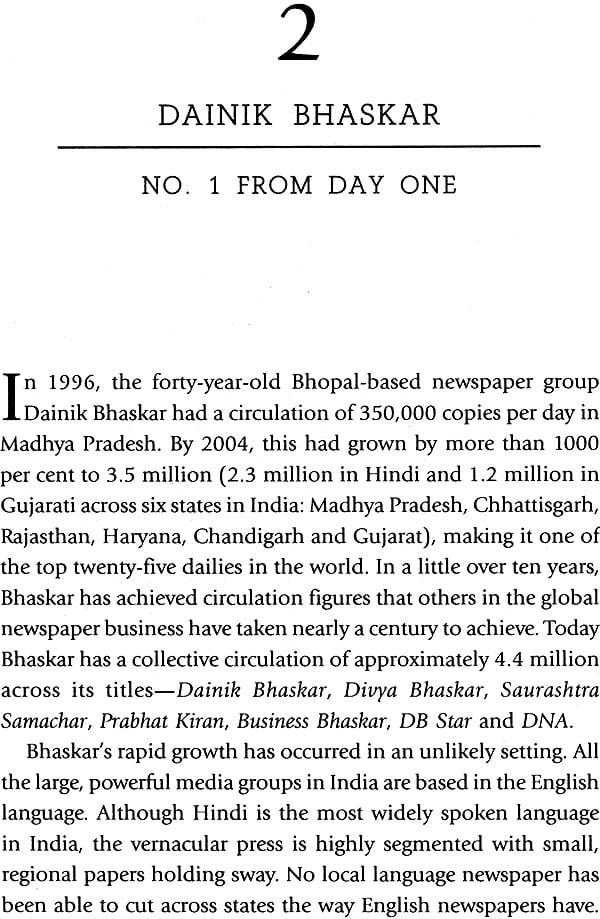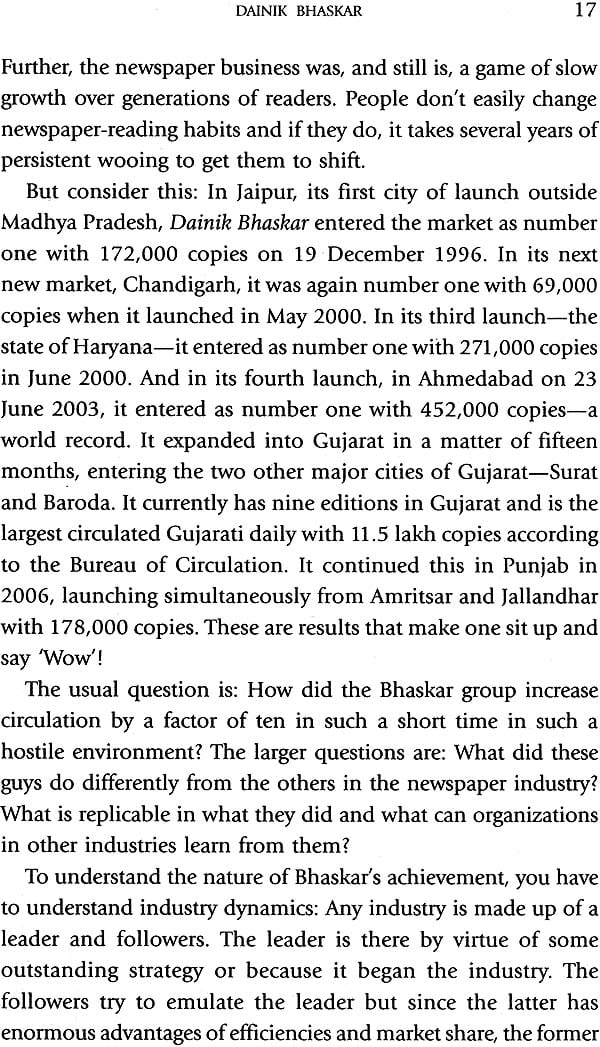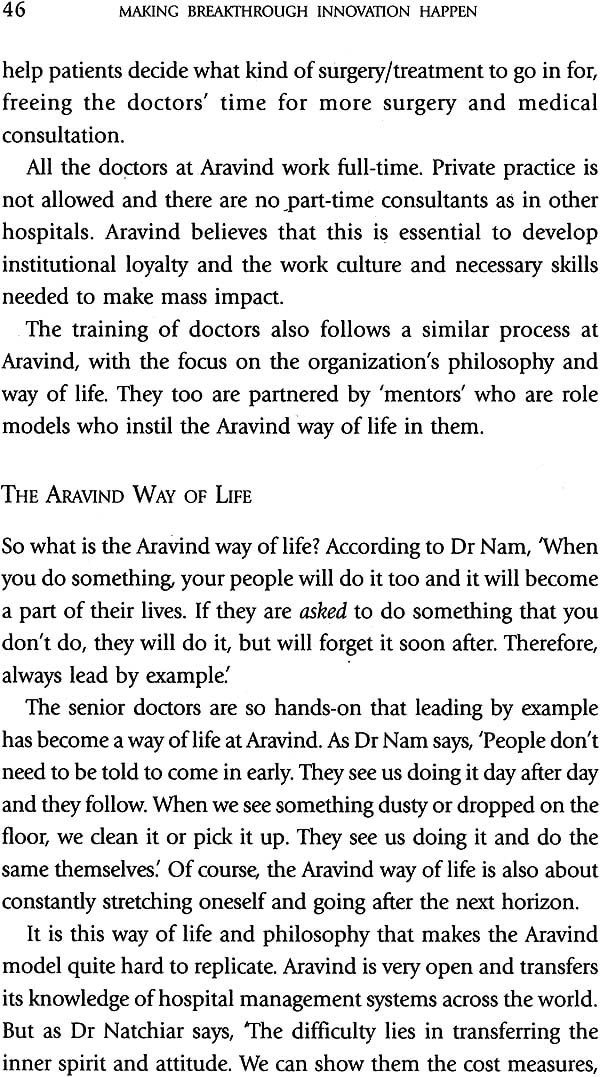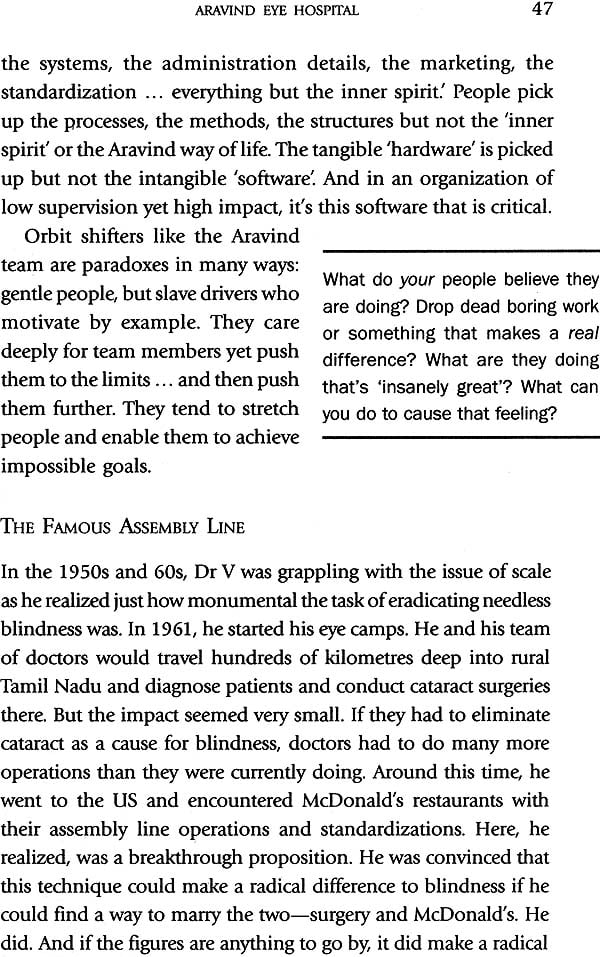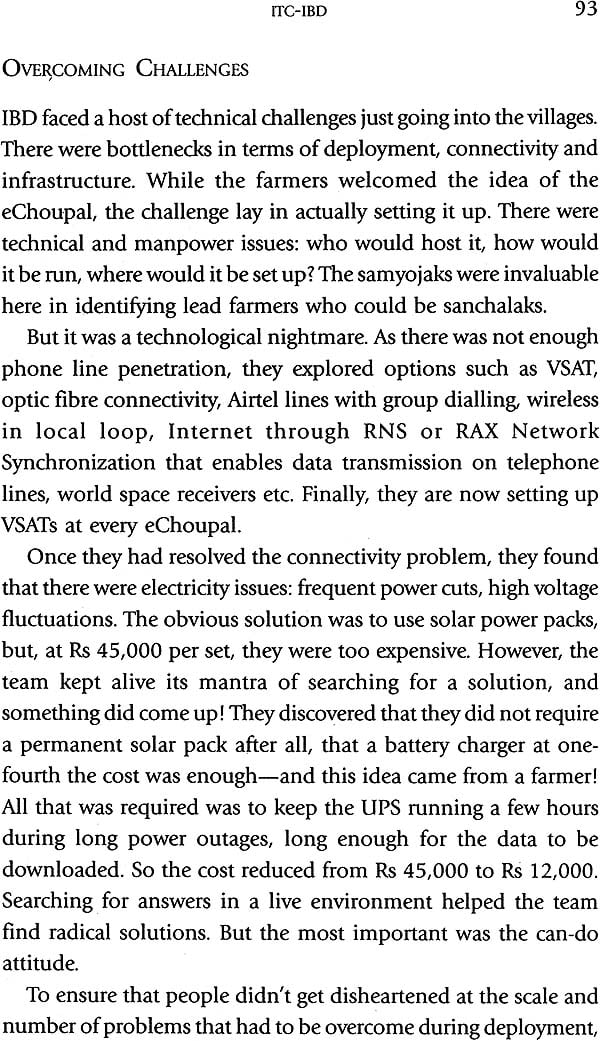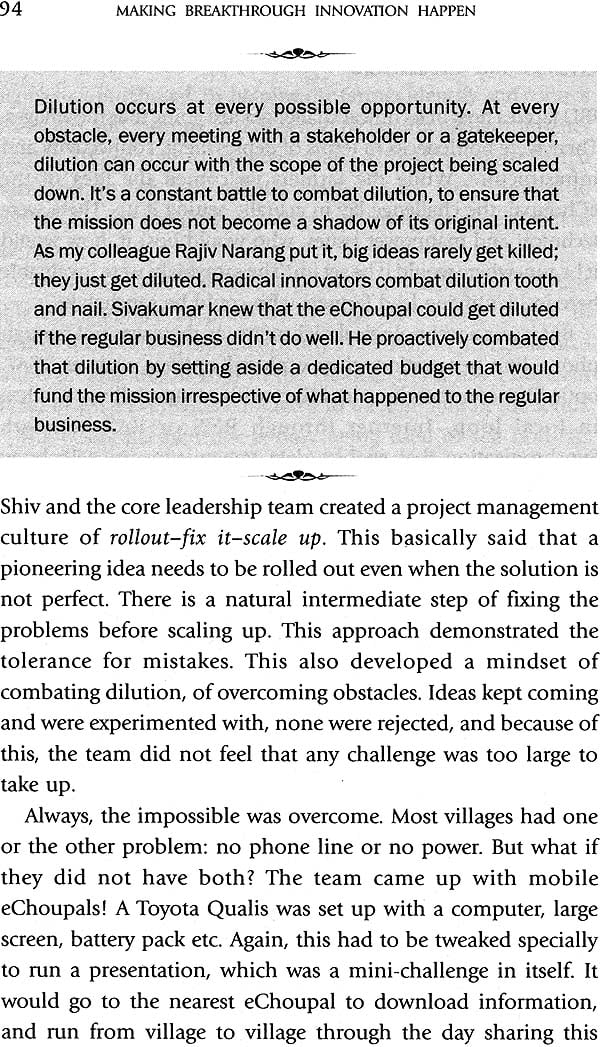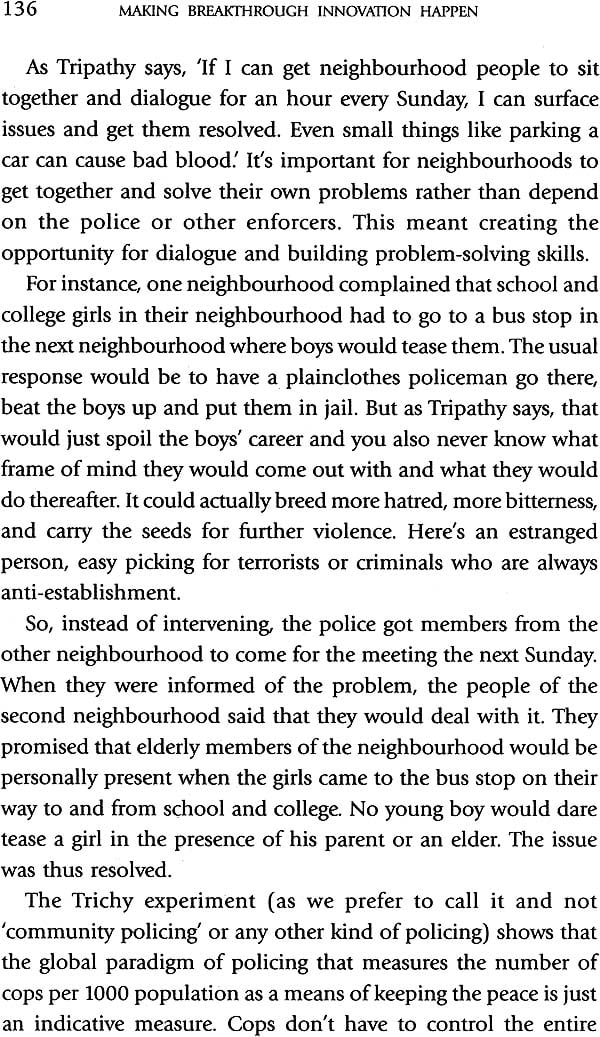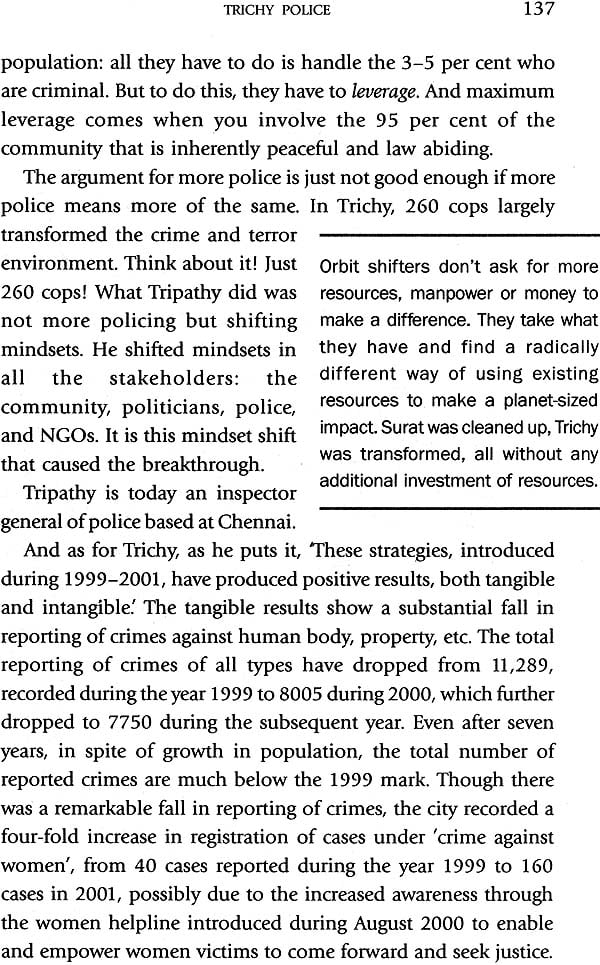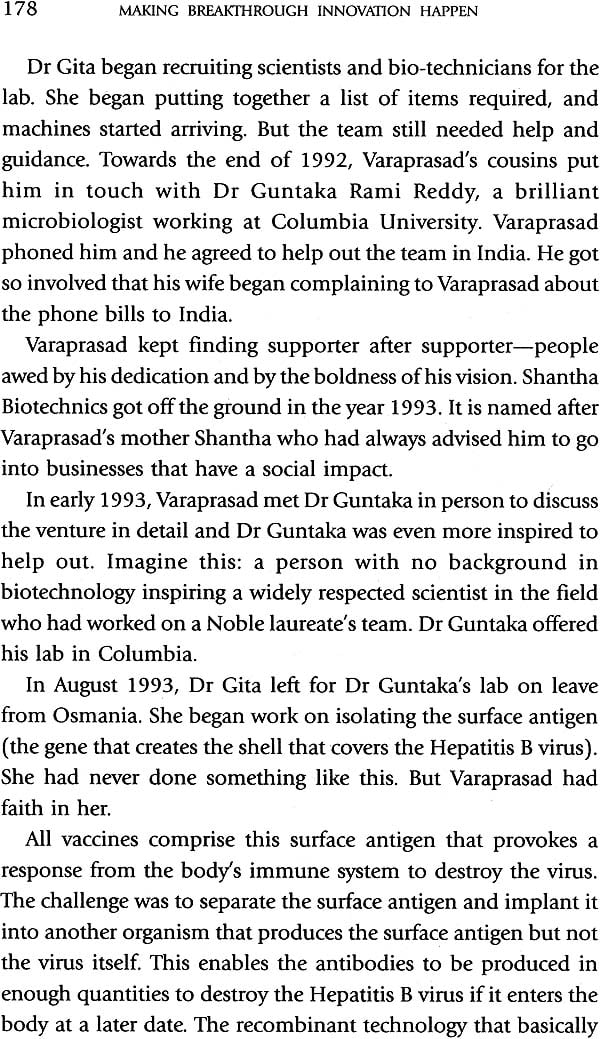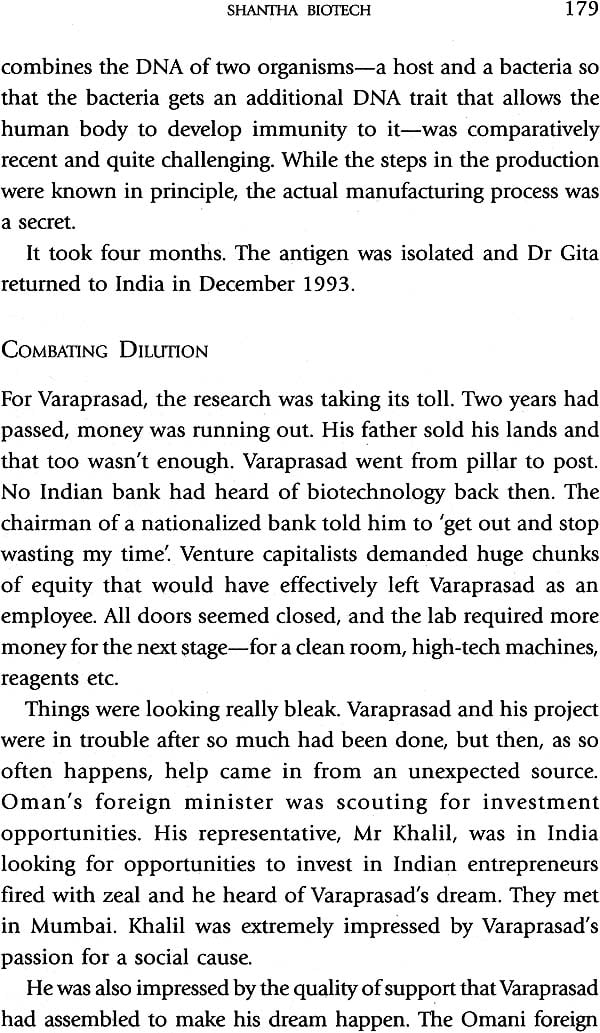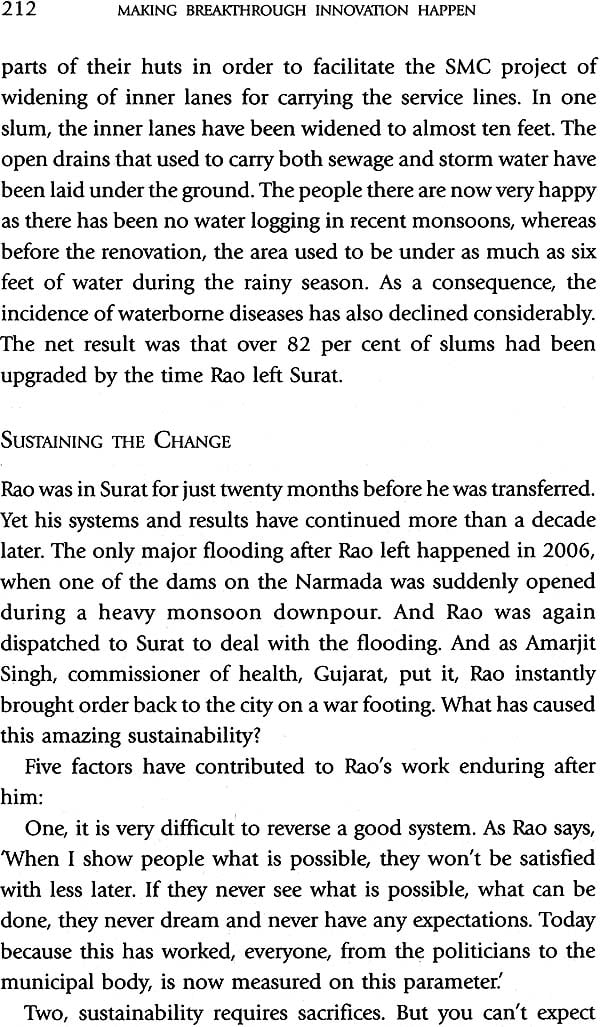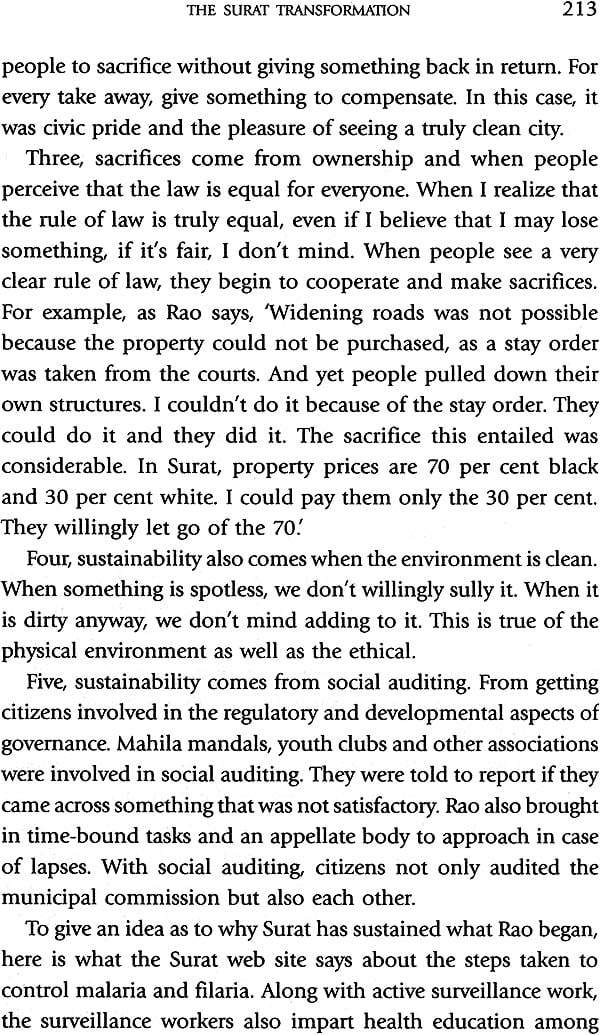
Making Breakthrough Innovation Happen (How Eleven Indians Pulled off the Impossible)
Book Specification
| Item Code: | NAG572 |
| Author: | Porus Munshi |
| Publisher: | Harper Collins Publishers |
| Language: | English |
| Edition: | 2013 |
| ISBN: | 9788172237745 |
| Pages: | 254 |
| Cover: | Hardcover |
| Other Details | 8.5 inch X 5.5 inch |
| Weight | 320 gm |
Book Description
Through the breakthrough achieved by these eleven organizations, Porus Munshi, an innovation consultant, shows that to do what is considered 'impossible' in your particular industry, you have to be subversive mindset can challenge and transform the status quo and make breakthrough innovation happen. In the process, if the existing business model needs to be turned on its head then so be it.
About the Author
Porus Munshi is a partner consultant at Erehwon innovation Consulting, a company dedicated to fuelling innovation in India.
He is a postgraduate in psychology, a lifelong student of martial arts from karate to boxing to Tai Chi, and was the author of a widely read column for the Hindu Businessline titled 'Work and You'.
Human performance, impossible dreams and causes, and taking on challenges fascinate him. In his work with clients across industries Munshi is known as someone who releases and unblocks the innate potential of people, so that they begin to conceptualize, innovate and achieve what they previously believed and achieve what they previously believed to be impossible. He triggers and facilitates innovation missions and works with top leadership teams, helping them make mindset shifts.
Porus lives in Banglore with his wife and daughter.
Foreword
When you think of innovation, which companies come to mind? Apple, 3M, Google, Sony? Perhaps Dupont, Microsoft, Starbucks and Virgin? Can you think of an Indian company? Rarely does the name of an Indian company come up at first thought, or even as a second thought. When prodded, most people scratch their heads, pause, think, and then a name or two gets mentioned almost as an afterthought.
Why does this happen? Is it because there are no Indian innovations worth talking about, or is it because we don't know of them, or is it simply because we as a race are just too critical of ourselves and in too much awe of the developed world to believe in ourselves and in what we have accomplished.
Are we merely going to be the land of jugaad-where quick- fix improvisations are used to tackle life's hassles? How can we take this intrinsic ability to improvise, and convert it into a national advantage? How do we move from small-time jugaad to high-value and high-impact innovation?
The last decade has seen the emergence of true innovation in India. We have seen Indian companies being acknowledged as innovators in software services, pioneering the creation of entirely new industries like KPO (E Value Serve). From doing, copying and improvising products, we are now beginning to create breakthrough products. Indian companies have dearly surfaced as pioneers in creating new models to capture the value at the bottom of the pyramid. Further, we have started to innovate for global markets too. Companies are now beginning to beat and not merely meet global benchmarks. It is possibly the onset of an innovative India where we are starting to challenge existing legacies; an innovative India where Indian entities of MNCs are becoming a springboard for innovation and aren't just clones of a distant parent; a changing India where government institutions are innovating to impact public services too.
This book is a culmination of a six-year joint discovery effort of Erehwon Innovation Consulting and the Marico Innovation Foundation. This endeavour aims at identifying genuine breakthrough innovations from within India and then uncovering cutting-edge insights into what these innovators did differently to make the impossible happen. The eleven innovations covered in this book provoke a change of reference points across industries and domains. The book-will spark new insights into:
1. Innovating legacy mindsets: Established industries are usually populated with old and rigid mindsets. These legacy attitudes cut across all players in the industry, leading to a disease of sameness-everything, from products, packaging and promotions to advertising, looks the same.
Innovating in an industry steeped in legacy requires the courage to challenge and go beyond well-entrenched paradigms. This is very difficult in a hierarchical culture like ours. Take the hundred- plus-year-old newspaper industry. Legacy mindsets in an old and established industry like this are huge, like the belief that it takes years to establish a leadership position. However, Dainik Bhaskar became market leader on Day One of launch in every city in Rajasthan, Chandigarh, Haryana and Gujarat, by using a radical marketing strategy.
2. Legacies in industries are difficult to challenge and organization legacies can be as tough to overcome. Organization legacy comes from past successes and deep-rooted culture. Chola Vehicle Finance brings alive what it takes to break through a risk- averse culture and unleash new strategies for quantum growth. Innovating to take on giants: In many organizations, there is awe and fear of and a deference towards giants, towards size. The belief is that if we provoke a giant he will come after us and we can't take him on. We are too small, too helpless, too resource- starved, and too weak to challenge.
The last decade has seen the emergence of challengers like CavinKare and Su-Kam (and Nirma earlier). They have demonstrated how entrepreneurs can create winning ideas even in markets dominated by giants. The founders of both CavinKare and Su-Kam are not in fear of MNCs; they display a positive irreverence. They believe that they can take on MNCs with 'new insight ideas'. They are new reference points for all entrepreneurs because they break the myth that R&D and technology-led innovation can happen only in large organizations. They demonstrate how often an entrepreneurial organization can be better at innovating.
3. Innovating for underserved markets: There are millions of consumers who earn between two and five dollars a day. This forms a huge unserved market and many organizations want to be able to tap into it. However, most companies employ a largely imperialistic mindset while trying to succeed in underserved markets. They believe that a 'no frills, knocked down' version of a successful product or strategy will be good enough for 'these poor people'. They fail to realize that this market does not want a poor man's Citibank; they want a Grameen Bank.
ITC-IBD, the company behind the revolutionary eChoupal idea, is a reference point of how a large organization can create an innovative business model that caters to the unique needs of farmers. An organization in Madurai has innovated and created an innovative business model that provides eye care to the economically handicapped. Aravind Eye Hospital evolved an eye surgery technique that increases a surgeon's productivity by a factor of ten. The business model ensures that millions of poor, visually impaired people can be operated for free or nearly free, and that the hospital still makes 40 per cent operating profit. It performs 200,000 cataract surgeries a year, making it the largest ophthalmology institution in the world. Further, students from Harvard and Iohns Hopkins come here for exposure and training. If an eye hospital in one of the quietest corners of India can become such a global benchmark, what's stopping the rest of us?
MNCs: INNOVATING to Go BEYOND CLONING GLOBAL SUCCESS
This streak of innovation in India is not just visible in local entrepreneurial organizations, but also in the Indian entities of global MNCs.
Bosch India has been made the centre of competence for a particular single cylinder pump, called the PF pump, used in diesel engines. For more than a decade, this centre of competence worked only at tweaking products developed in Germany and this too after extensive permission seeking. A crisis moved them from looking up to Germany to taking action on their own.
Introduction
One key question has for long fascinated us at Erehwon Innovation Consulting and the Marico Innovation Foundation: What does it take to make orbit-shifting innovation happen? To find an answer we began the Challenger Research Project. We met over 180 people in organizations across forty industries and sectors and identified challengers or orbit shifters based on the criteria of impact, uniqueness and leverage. Once identified, we conducted first-hand and in-depth research into individuals and organizations that have made orbit-shifting innovation happen.
The driving force behind both Erehwon and the Marico Innovation Foundation was to find a way to help India become a truly developed nation in its own right. If the 1980s and 1990s were the decades of Japan and quality, can the 2010s and 2020s be the decades of India and innovation? Can we use innovation as a springboard to tackle the challenges facing India today? And could Erehwon and Marico, by identifying just what it is that makes such innovation happen, play a role in creating this desired future? The research study was the first step in this direction.
(Altair Engineering came in later as partners for a research study on what enables and hinders product innovation in India. Three mission studies emerged from this research: Su-Kam, Titan Edge and Bosch India.)
We were dear that this wouldn't be the usual research that determines what innovators do differently and then seeks to develop a how-to list of things to do. How orbit shifters do something is certainly interesting and useful. But to us what was more critical was how they think! As Dr N. Natchiar of Aravind Eye Hospital, one of the orbit-shifting innovators in our research, says, We keep sharing our best practices, processes and methods with other organizations ... But none of them is able to replicate what we do because they focus on the processes and not on the underlying philosophies that drive our organization: Really, the internal leads the external. As long as we focus on the external manifestations and not on the internal mindsets and beliefs that drive orbit-shifting innovation, we are going to be focusing on the wrong things and true replication won't happen. Therefore, we decided to focus on the mindsets and patterns of thought and action that drive orbit shifters.
CHOOSING THE ORBIT-SHIFTING MISSIONS
We chose companies and missions based not on scale alone but on the fact that each of them had shifted their industry's or sector's orbit in some way. These companies and missions had defied conventional wisdom and instead blazed their own paths.
We chose such missions not just from the corporate sector but also from the public service and social sectors, as we felt that if a mindset was truly effective, it should hold true across sectors. Also, it's limiting to learn from just one sector when amazing breakthroughs were happening in different sectors, with lessons for all.
From the corporate sector we chose Dainik Bhaskar, ITC-IBD, Shantha Biotech, Titan, Bosch, Chola Vehicle Finance, Su-Kam and CavinKare. From the public service sector, we chose the makeover of Surat city and the transformation of the police force at Trichy. From the social sector, we chose Aravind Eye Hospital.
Except for Shantha Biotech, none of the organizations in the corporate sector is from a sunrise industry. And yet each has made radical growth happen. Shantha Biotech is certainly in a sunrise industry, but it's also an industry it helped create in India, facing tremendous challenges along the way. For instance, its applications to the government of India for permission to develop a genetically engineered r-DNA vaccine kept getting lost for several months. Then they found that the powers that be in government didn't quite understand what genetically engineered meant. Since the application had the word engineered in it, it was sent off to the Public Works Department! WHAT WE FOUND
There is a pattern to making orbit shifts happen. Orbit shifters begin with a create-history kind of impossible challenge that engages the heart rather than appeals to reason. Next, they seek out cutting-edge insights to find ways of reaching that challenge. The breakthrough strategy emerges either from these insights or from a complete reframing of the established order. Then they constantly enrol the numerous stakeholders, gatekeepers, team members, influencers and regulators who can make or mar the mission. And not just enrol them, but actually infect them so that they become champions of the mission. And finally they consistently combat entropy and the near-inevitable dilution that takes place whenever something 'impossible' is attempted it takes a hawk eye and a consistent 'maximizing' mindset to ensure that dilution doesn't happen.
Contents
| Introduction | 1 | |
| 1 | The Dynamics of Breakthrough Innovation | 6 |
| SECTION I: SETTING AN ORBIT-SHIFTING CHALLENGE | 11 | |
| 02:00 | Dainik Bhaskar: No. 1 from Day One | 16 |
| 3 | Aravind Eye Hospital: | 34 |
| Making a Dent in Global Blindness | ||
| SECTION II: CHALLENGING THE ESTABLISHMENT THROUGH A BREAKTHROUGH INSIGHT | 53 | |
| 4 | Cavin Kare: Giving Giants Colds | 60 |
| 5 | ITC-IBD: Blowing up the Business Model | 75 |
| 6 | Bosch India: Innovation Blowback into Europe | 98 |
| SECTION III: ENROLLING TO A CAUSE | 111 | |
| 7 | Trichy Police: Shifting Policing Paradigms | 116 |
| 8 | Chola Vehicle Finance: Removing Escape Buttons | 139 |
| 9 | Titan Edge: Beating Deference | 152 |
| IV: COMBATING DILUTION | 167 | |
| 10 | Shantha Biotech: Unleashing Biotechnology in India | 172 |
| 11 | The Surat Transformation: Urban Renewal | 192 |
| 12 | Su-Karn: Creating an Industry | 217 |
| Afterword | 233 | |
| A Note on Erehwon Innovation Consulting and Marico Innovation Foundation | 235 |
